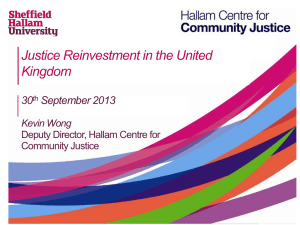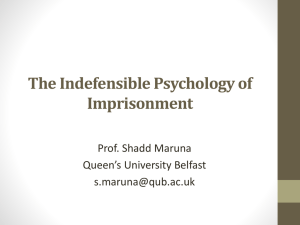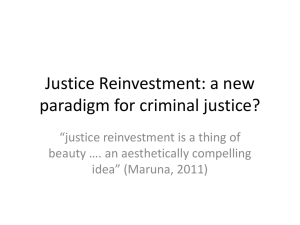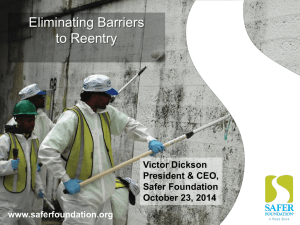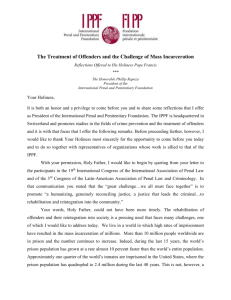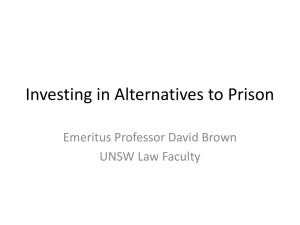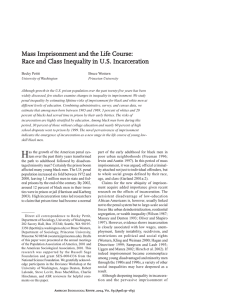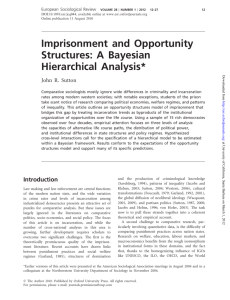Searching for a social democratic narrative in criminal justice
advertisement
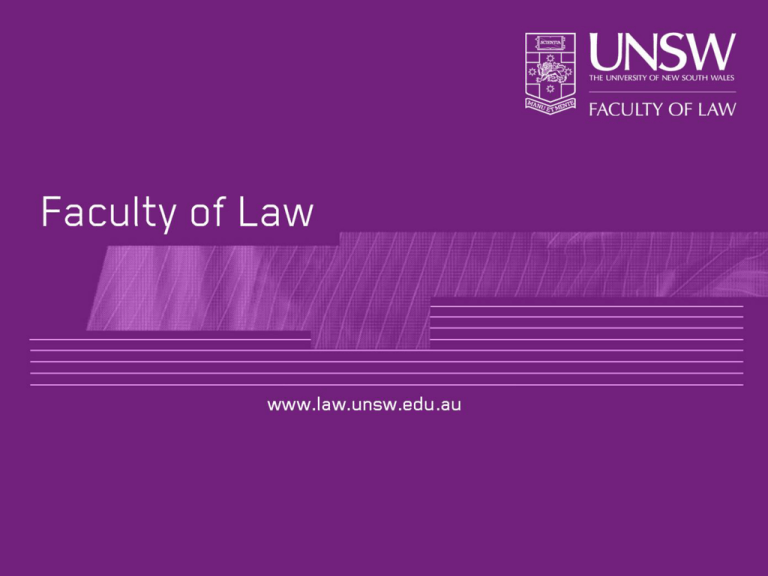
SEARCHING FOR A SOCIAL DEMOCRATIC NARRATIVE IN CRIMINAL JUSTICE EMERITUS PROFESSOR DAVID BROWN, LAW FACULTY, UNSW SEARCHING FOR A SOCIAL DEMOCRATIC NARRATIVE IN CRIMINAL JUSTICE http://www.youtube.com/watch?v=Q7UX8KASASU Always blow on the pie: safer communities together Social Democracy : Kevin Rudd, The Monthly 2008? ‘The time has come, off the back of the current crisis, to proclaim that the great neo-liberal experiment of the past 30 years has failed, that the emperor has no clothes. Neo-liberalism, and the free-market fundamentalism it has produced, has been revealed as little more than personal greed dressed up as an economic philosophy. And, ironically, it now falls to social democracy to prevent liberal capitalism from cannibalising itself.’ ‘Social-democratic governments face the continuing challenge of harnessing the power of the market to increase innovation, investment and productivity growth - while combining this with an effective regulatory framework which manages risk, corrects market failures, funds and provides public goods, and pursues social equity.’ Social Democracy : Kevin Rudd, The Monthly 2009 ‘Social justice is also viewed as an essential component of the social-democratic project. The social-democratic pursuit of social justice is founded on a belief in the self-evident value of equality, rather than, for example, an exclusively utilitarian argument that a particular investment in education is justified because it yields increases in productivity growth (although, happily, from the point of view of modern social democrats, both things happen to be true). Expressed more broadly, the pursuit of social justice is founded on the argument that all human beings have an intrinsic right to human dignity, equality of opportunity and the ability to lead a fulfilling life. ...Accordingly, government has a clear role in the provision of such public goods as universal education, health, unemployment insurance, disabilities insurance and retirement income.’ SEARCHING FOR A SOCIAL DEMOCRATIC NARRATIVE IN CRIMINAL JUSTICE The global financial crisis provides an opportunity for a rethink in criminal justice policy as part of a more general reconsideration of the excesses of neo-liberalism. Rather than simply engage in market intervention solely to stimulate demand and ‘business as usual’, attempts should be made to restructure and regulate the market in social directions, requiring greater environmental sustainability, reducing income differentials, curbing cultures of greed and gambling in the financial sector, re-configuring the tax system in a progressive direction and investing in public transport and other infrastructure promoting community based sharing networks which are not based on a constant increase in consumerism, consumption and narcissism. SEARCHING FOR A SOCIAL DEMOCRATIC NARRATIVE IN CRIMINAL JUSTICE Criminal justice should be part of this broadly social democratic narrative. Criminal justice issues need to be connected with broader social and economic policies. Aspects of this connection might involve a range of tasks such as : rerouting penal policy from the exclusive terrain of individual culpability, so familiar in tabloid, talk-back and political discourse; engaging in a comparative penology which emphasises political economy and inequality; exploring a range of developments in ‘justice reinvestment’; redirecting resources from the burgeoning prison sector into practical assistance with ex-prisoner resettlement; and challenging the ‘pathological disciplinarities’ and ‘imaginary penalities’ of neo-liberal managerialism. Recognising social determinants as well as individual culpability Doctrinal criminal law and popular debate over crime located primarily at level of individual action, characterised in terms of culpability/responsibility, guilt, ‘evil’. Set of wider discourses which locate causal or precipitating factors in social, cultural, economic and political forces beyond the individual. To point to the social determinants of crime not inconsistent with holding offenders accountable Comparative penology: International imprisonment rates United States 738 per 100,000 pop Russia 611 South Africa 335 New Zealand 186 United Kingdom 148 Australia 126 China 118 Canada 107 Italy 104 Germany 95 France 85 Sweden 82 Norway 66 Japan 62 Indonesia 45 India 30 Source: Walmsley, World Prison Population List, 7th edn. : www.prisonstudies.org Comparative penology: N. Lacey, The Prisoners’ Dilemma (2008) p60 Country Imprisonment rate Per 100,000 2006 homicide rate (%) Foreign Prisoners % Co-ordination index rating (0-1) 6.4 3.3 9.3 13.6 19.5 0.00 n/a 0.21 0.07 0.36 31.7 33.2 28.2 21.4 0.66 0.87 0.95 0.69 26.2 18.2 8.0 17.2 0.69 0.70 0.72 0.76 7.9 0.74 Neo-liberal countries (Liberal market economies) USA South Africa New Zealand England/Wales Australia 737 336 186 148 125 5.56 55.86 2.5 1.6 1.87 Conservative corporatist (Co-ordinated market economies) Netherlands Italy Germany France 128 104 94 85 1.51 1.5 1.15 1.71 Social democracies (Co-ordinated market economies) Sweden Denmark Finland Norway 82 77 75 66 1.1 1.02 2.86 0.95 Oriental corporatist (Co-ordinated market economy) Japan 62 1.05 Comparative penology: Penal culture and political economy Key factors: The structure of the economy Levels of investment in education and training Disparities of wealth Literacy rates Proportion of GDP on welfare Co-ordinated wage bargaining Electoral systems Constitutional constraints on criminalisation Institutional capacity to integrate ‘outsiders’ Comparative penology: Penal culture and political economy The relatively disorganised, individualistic liberal market economies particularly vulnerable to penal populism -‘liberal/co-ordinated market economy’ distinction. ‘Co-ordinated systems which face long term relationships –through investment in education and training, generous welfare benefits, long term employment relationships -have been able to resist the powerfully excluding and stigmatising aspects of punishment’ cf liberal market systems oriented to flexibility and mobility –turn to punishment as a means of managing an excluded population. The racial component in Imprisonment rates Indigenous imprisonment rates AboriginalImprates2008AIC.pdf Indigenous Australians 1 in 4 of prison population 2000- 2008 imp rate for Indigenous increased by 34% from 1,653 per 100,000 Indigenous adults to 2,223 Increase 7 times that of non-Indig -123 to 129 per 100,000 BOCSAR 1 in 4 young Indig men are being processed through the crim justice system every year Estimated that in 5 young Indig males under some form of criminal justice supervision Pratt on Scandinavian ‘exceptionalism’ Pratt on Scandinavian ‘exceptionalism’ Low rates; exceptional prison conditions Origins in: cultures of equality –: welfare state; universal social security –: high levels of trust and solidarity –: bodily punishments scaled down or abolished Pratt on Scandinavian ‘exceptionalism’ – Strong state bureaucracies with considerable autonomy and independence from political interference – Strong interventionist central state – mass media controlled by public organisations – High levels of social capital – Power and influence of expertise ‘Justice reinvestment’ Calculates public expenditure on imprisonment in localities with high concentration of offenders and diverts a proportion of that expenditure back into programs and services in those communities. US developments –Council of State Government Justice Centre -US state expenditure on corrections risen from $12 billion to $52 billion 1988-2008. Half of those released will be reincarcerated within 3 years Prison reductions in some US states –New York 20% 2000-2008; New Jersey 19% 1999-2009 Support from business leaders PEW Foundation Report ‘Justice reinvestment’ UK developments –House of Commons Justice Committee –Cutting Crime: the case for justice reinvestment (2010) ‘Channel resources on a geographically targeted basis to reduce crimes which bring people into the prison system’ ‘crim justice system facing a crisis of sustainability’ – prison as a ‘free commodity’ while other rehab and welfare interventions subject to budgetary constraints’ Recommended capping of prison pop and reduction to 2/3 current level and devolution of custodial budgets financial incentive for local agencies to spend money in ways which will reduce prison numbers ‘Justice reinvestment’ Senate Legal and Constitutional Affairs Committee Report Access to Justice 2009 Rec 21 ‘the federal, state and territory governments recognise the potential benefits of justice reinvestment, and develop and fund a justice reinvestment pilot program for the criminal justice system.’ Aust 2008-09 $2.79 billion on prisons, $205 per prisoner per day Spatial dimension –’million dollar blocks’ –’millions are being spent on the neighbourhood but not in it’ Papunya NT -72 adults in prison at cost of $3,468.960 for community of 400 people. ‘Justice reinvestment’ Devolving accountability and responsibility to the local level Data driven –’incarceration mapping’ – linked to ‘asset mapping’ eg Vinson’s ‘post codes’ cf ‘hot spot’ mapping Links with National Indigenous Law and Justice Framework 2009-2015 Queensland Justice Agreement –specific goal to reduce the rate of ATSI people incarcerated by 50% by 2011. Criminogenic effects of incarceration –cf limited economic benefits of prison –Spelman - 10% increase in imp rate produces 2-4% decrease in crime rates Effects of incarceration itself – ‘crime education’; fracturing of family and community ties; hardening and brutalisation; effects on mental health. Post incarceration effects- labeling; deskilling; reliance on criminal networks; reduced employment opportunities; civil disabilities. Third party effects –on families and communities. Criminogenic effects of incarceration ‘high rates of imprisonment break down the social and family bonds that guide individuals away from crime, remove adults who would otherwise nurture children, deprive communities of income, reduce future income potential, and engender deep resentment toward the legal system. As a result, as communities become less capable of managing social order through family or social groups, crime rates go up’ - Rose and Clear Criminogenic effects of incarceration ‘Mass imprisonment’ ‘normalisation, transmission and reproduction’ of imprisonment Levy -20% of Aboriginal children have a parent or carer in prison Incarceration one more contributor to social dysfunction – weakening communities and reducing social capital reformulate the key question –Vera Institute ‘the pivotal question for policymakers is not ‘Does incarceration increase public safety, but rather is incarceration the most effective way to increase public safety?’ redirecting resources from the burgeoning prison sector into practical assistance with ex-prisoner resettlement; reduce recidivism rates challenging the ‘pathological disciplinarities’ and ‘imaginary penalities’ of neo-liberal managerialism. neoliberalism has inflected disciplinarities in the direction of the ‘pathological’ and away from ‘democratic rule usage’ (Carlen 2008: 431). Similarly in relation to managerialism, neoliberal formulations of risk, KPIs and audit criteria with their emphasis on narrowly defined notions of ‘efficiency’ and ‘cost’, increase the tendency for audit measures to become inward looking ends in themselves, eschewing more broadly defined social aims and outcomes that were and are aspirations under social welfarist and social democratic regimes, however much they might be difficult to measure, flawed or unmet in practice. Conclusion Prospects of reversing the expansion of imprisonment depend at most general level on mitigation of neo-liberal political, economic and social policies – argue for a politics of inclusion, social welfare provision and social solidarity –renewal of social democracy Imprisonment rates need to be consciously reduced as matter of government planning; Imp rates not just an aggregation of individual criminal acts but artifacts of social, economic and political and legal policy Conclusion Adopt justice reinvestment approaches Recognise criminogenic effects of incarceration policy and resources diverted from the custodial to welfare, educational and training programs in community settings. challenge the ‘pathological disciplinarities’ and ‘imaginary penalities’ of neo-liberal managerialism. Always blow on the pie: safer communities together http://www.youtube.com/watch?v=Q7UX8KASASU Not just blowing on the pie –fairer sharing of the pie ‘Social justice is also viewed as an essential component of the social-democratic project. The social-democratic pursuit of social justice is founded on a belief in the self-evident value of equality, rather than, for example, an exclusively utilitarian argument that a particular investment in education is justified because it yields increases in productivity growth..’ Kevin Rudd

